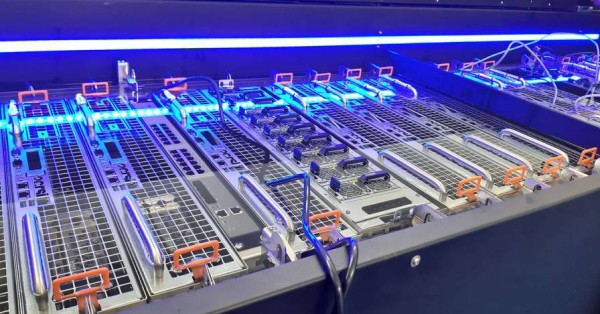Ericsson’s Smart Factory in Texas: Leading the Fourth Industrial Revolution
Ericsson’s smart factory based in Texas, US, builds 5G and advanced antenna systems radios. The smart factory is 25% more energy-efficient, produces 17% of its required power on-site via solar panels, uses 40,000-gallon tanks to collect and reuse rainwater, and reduces shipping distances by up to five times.
The World Economic Forum (WEF) recognized Ericsson as a global front-runner in the Fourth Industrial Revolution (4IR). It awarded Ericsson’s US-based smart factory site its prestigious “Global Lighthouse” designation, acknowledging the deployment of next-generation technology and its impact – including 2.2 times improved output per employee compared to a similar factory without the automation and 4IR improvements.
Smart Factory Use Cases: Revolutionizing Manufacturing
Smart Factory: Energy Monitoring and Management
Factories use a significant amount of energy. Lacking visibility into energy consumption at the device level prevents factory management from incorporating optimization strategies. A connected energy monitoring and management system enables data gathering from all the factory’s energy appliances. Factories can use the real-time view of energy consumption to preset rules for turning on or off relevant appliances, reducing energy consumption.
Challenges
- 40% of energy and 70% of electricity is used by buildings, including factories.
- Inability to define energy optimization strategies due to a lack of information on energy consumption at the appliance/device level.
Solution
- Monitoring of energy consumption by appliances.
- Gathering and tracking of real-time energy consumption.
- Rule-based turning on/off appliances.
Benefits
- Reduction in energy bills by 5% from monitoring and controlling energy consumption.
- Ability to negotiate consumption per unit price with energy utility companies due to visibility into actual power consumption.
Potential Industry Applications
- Manufacturing
- Agriculture
- Retail & smart buildings
Smart Factory: 5G-Powered Augmented Reality for Remote Support
Factory maintenance is difficult due to the lack of availability of on-site labor. It is also expensive to have trained labor on-site or to fly in/out vendors or employees for repairs.
Augmented Reality (AR) powered with 5G can provide factory members with virtual guidance from experts for troubleshooting and equipment repair. The AR system with a headset can share real-time video, audio, and annotations for faster and more precise support globally.
Challenge
- Difficulty completing factory maintenance due to a lack of specialized on-site experts. This problem will further escalate as 27% of the US manufacturing staff retire in the next ten years.
- High cost for having on-site labor as well as flying them out to factories for timely repairs.
Solution
- 5G-powered AR headsets for maintenance teams for troubleshooting and repairing equipment in conjunction with vendor support teams and real-time access to the knowledge base.
Benefits
- Reduce factory maintenance labor by 10%.
- Decrease equipment downtime by 5% via efficient troubleshooting.
- Reduce vendor service costs by 20-25%.
- Reduce travel costs by 40-50%.
Potential Industry Applications
- Manufacturing
- Energy & Utilities
- Healthcare
Smart Factory: Connected Drones for Factory Inspection
Factories require comprehensive surveillance, which is both difficult and expensive. Dispatching staff for surveillance of large factory premises is also very costly and challenging.
Autonomous drones can patrol the factory premises 24/7. They can provide the required factory operational and surveillance information. The smart drones can automatically fly, i.e., take off and land and recharge themselves, reducing labor and security costs.
Currently, the 4G network connects the drones. In the future, the factory can use the 5G network for connecting the drones, which would provide live video streaming and precise positioning.
Challenge
- It is difficult and expensive to provide 24/7 surveillance and inspection at factories via dispatching people.
Solution
- Day and night patrolling by inspection drones, responding to any alarms and transmitting live video, landing, and recharging by itself.
- Lower personnel risk with 24/7 surveillance coverage.
Benefits
- Reduction in the workforce by 10%.
- Reduction in inspection costs (e.g., vehicles, personnel) by 10-15%.
Potential Industry Applications
- Manufacturing
- Energy & Utilities
- Public safety
- Retail & smart buildings
Smart Factory: Digital Compliance for Safety and Quality
Factories must ensure their employees’ and visitors’ safety and security on the factory premises, i.e., whether the visitors and employees are wearing protective clothing and accessories, e.g., electrostatic discharge jackets and helmets. It is a time-consuming and cumbersome process to manually check whether each personnel complies with the set security and safety standards.
A camera connected with a video analytics platform can detect whether the employees and visitors are wearing safety attire. The video analytics platform can improve safety and quality compliance and reduce factory incidents.
Challenge
- Factories need to ensure continuous safety and security of all visitors and employees.
- It is difficult to manually verify that visitors and employees comply with safety and security rules, e.g., wearing jackets, eye and hearing protection.
Solution
- The video analytics platform can detect and notify visitors and employees wearing required safety jackets, shoe coverings, eye, and hearing protection.
- The platform also detects people, events, and objects.
Benefits
- Improve compliance and reduce incidents by 10%.
Potential Industry Applications
- Manufacturing
- Energy & Utilities
- Healthcare
Smart Factory: Monitoring Factory Environment
Manufacturers can incur up to $1000 in output and increased waste due to environmental factors such as high temperature and humidity. It can also affect the working environment for the employees.
Factories can deploy an environment monitoring solution to collect and analyze environmental factors such as temperature and humidity. The related insights can help in increasing manufacturing quality as well as reducing waste production conditions.
Challenge
- Environmental factors such as 90 degrees or above temperature can cost factories up to $10K in output and increase waste.
- It isn’t easy to understand how environmental factors impact factory production and the employees’ working environment.
Solution
- Gather and store the environmental monitoring data such as temperature, and humidity from the factory floor in the data lakes for correlation purposes.
Benefits
- Waste reduction by 5% because of production conditions such as humidity and high temperatures.
Potential Industry Applications
- Manufacturing
- Energy & Utilities
- Agriculture
- Retail & smart buildings
Smart Factory: E2E Digital Thread for Production
Unplanned machine downtime results in a very high cost for manufacturers. One of the key contributing factors for unplanned downtime is the lack of component history, making it difficult to identify the downtime’s root cause.
Gathering and maintaining an end-to-end digital thread of the complete history of radio components, its suppliers, related tests, past troubleshooting, and a single source of truth can reduce the repair costs with faster root-cause analysis.
Challenge
- The cost of unplanned downtime for manufacturers is approximately $50 billion per year.
- It is difficult to identify the root cause of failure due to lack of component historical information, resulting in machine downtime, rework, increased repair costs, and recurring failures.
Solution
- Single source of truth (in a data lake) and complete history of each of the radio’s components and its production, such as supplier information, test results, past troubleshooting – for faster root-cause analysis.
Benefits
- Reduction in repair costs by 15-20% from reduced machine downtime, rework, and recurring incidents.
Potential Industry Applications
- Manufacturing
- Healthcare
Smart Factory: Wearable Devices for Alerts and Escalation
It is time-consuming to check all the factory appliances continuously. Smart devices can provide alerts and suggest actions to service providers in real time, based on past actions. The uptime of machines increases with faster response times enabled via the smart devices and smart alerting system.
Challenge
- Factory operators and responsible personnel do not get a real-time alert if there is an issue.
- If operators are not around the production line computer, they will not update the issue, resulting in production loss.
- There is also no guidance to the operator on the actions required for issue resolution.
Solution
- Smart wearables can provide real-time alerts and alarms to the operator and also suggest immediate workflow actions.
Benefits
- Machine uptime increases by 5% from faster response time by the operator.
Potential Industry Applications
- Manufacturing
- Energy & Utilities
- Public safety
- Healthcare
Smart Factory: In-factory Asset Tracking
Continuously checking factory assets is a time-consuming process. Not detecting empty material magazines on time can result in production loss.
Factory asset tracking systems can provide real-time alerts to the service providers and suggest actions based on past responses. It increases the machine’s uptime by accelerating the response time.
Challenge
- Lack of information on factories’ critical assets location and status can lead to significant downtime. On average, it costs factories $100K for an hour of downtime.
- Looking for in-factory assets leads to waste of time and rework.
Solution
- Real-time tracking of critical assets location, status, and condition via integrating the asset tracking solution with sensors on the factory floor.
- Tracks production progress and provides insights to the operators and managers on the factory floor.
- Provides a real-time update on the finished products from the production floor.
Benefits
- Increase repair tech productivity by 10%.
- Reduced rework and waste by 5%.
- Costs can be reduced by 10% on the indirect purchase of spare items.
Potential Industry Applications
- Manufacturing
- Retail & smart buildings
- Healthcare
Smart Factory: Visual Inspection Based on Machine Learning
Visual inspection is a time-consuming process with a high risk of error. Background clutter and illumination conditions in the factory impact traditional visual inspections of the machines.
A high-resolution camera with machine learning algorithms can increase visual inspection accuracy and reduce the inspection time.
Challenge
- Visual inspections result in errors in the range of 20-30% and are also time-consuming.
- It is a struggle for existing machine vision to handle specific instances, e.g., background clutter or illumination conditions.
- Machine downtimes from high false positives and missing errors.
Solution
- The accuracy of the production area board inspection is improved via a combination of high-resolution cameras and machine learning algorithms.
Benefits
- Decrease in labor’s inspection time by 5%.
- Throughput increase by 5% due to a reduction in false-positive failures.
Potential Industry Applications
- Manufacturing
- Energy & Utilities
Smart Factory: Automated Unpacking Process
Factories typically use 50-80% of manual labor for activities. The process of gradual unpacking and placing of materials from one container to another is also labor-intensive.
Materials are not delivered in a particular order, making the process to structure and organize it time-consuming.
An automated robot can identify and pick material from unstructured bins. It can then place the materials onto trays in particular locations and orientations, which the production lines can automatically receive. This automation process, also referred to as the decanting process, can reduce the labor kitting time by 50% and increase production uptime.
Challenge
- Factory activities such as unpacking and placing components onto trays, in a particular order to be picked up by automated production lines, is a manual time-consuming labor-intensive activity.
- Overseas material is not delivered in the order required by the production lines.
Solution
- Autonomous robots pick materials from unstructured bins and place them on trays in particular locations and orientation for production lines to receive them automatically.
Benefits
- Warehouse operator labor reduces by 50%.
- Uptime increase by 5% from efficient unpacking.
Potential Industry Applications
- Manufacturing
- Agriculture
Smart Factory: Control Tower to Showcase Plant Dashboards
It is a cumbersome process for engineers to find correct and updated production data in the factories. In most cases, the data is stored in siloed systems, and there is no mechanism for the engineers to get overview data.
The central control tower system can provide a master overview of what is happening in the factory by accessing and correlating information from all the factory systems. It sends alerts for performance issues enabling faster response. The efficient alert communication and direct access to updated information from the central control solution save labor hours.
Challenge
- Engineers take 14-30% of their time finding the correct and updated production data in a large factory.
- The process and production information is stored in siloed systems in most cases, and it is difficult to combine all the info to provide a real-time master view.
Solution
- The central tower has access to all the information systems.
- It is integrated into the factory floor, related security and safety systems, and building management.
- The centralized tower provides flexibility and scalability to the factory.
- It also raises alerts for faster response.
Benefits
- Reduction in labor hours by 5% because of better communication as well as access to required information.
Potential Industry Applications
- Manufacturing
- Energy & Utilities
- Retail & smart buildings
- Healthcare
- Public safety






















